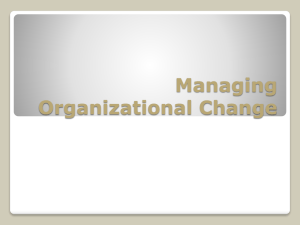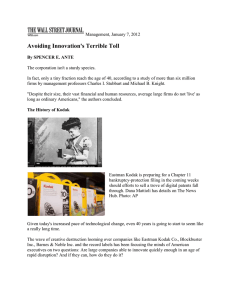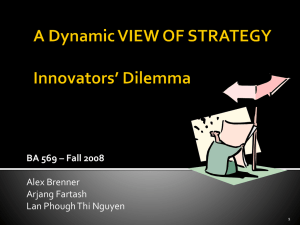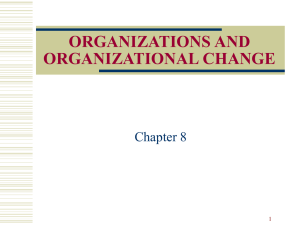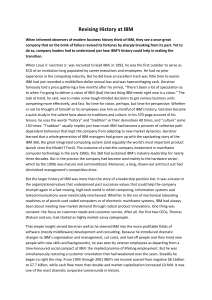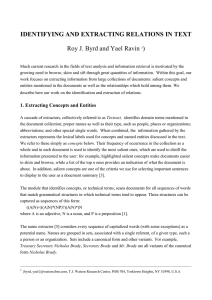Organizational Change
advertisement
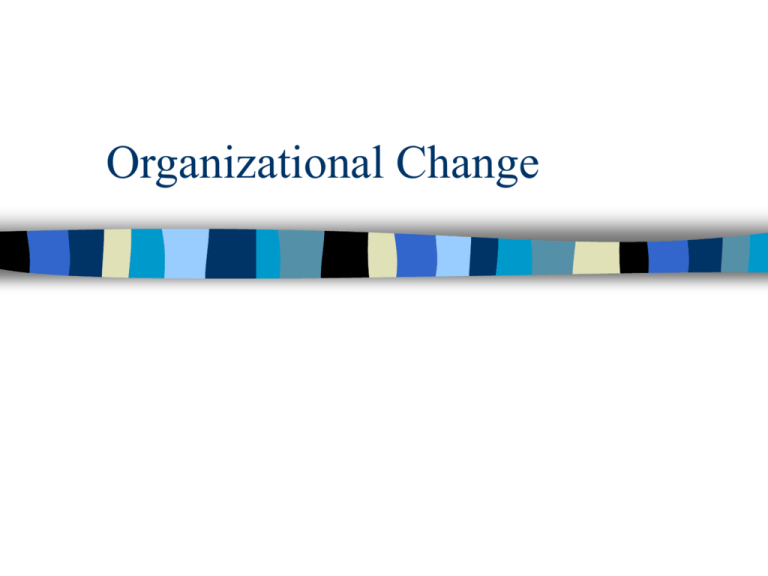
Organizational Change Often viewed as the best part of the job by managers. Making the organization better. Putting a person stamp someplace. Having an impact. Managers careers often based on making positive changes. Examples of change topics Financial—Lots of companies and overstating profits. Strategic--changing strategic goals (turnaround). Address IBM and EK Organizational (higher levels) Developing policies and procedures New product development Implementing a new customer service program such as phone courtesy Technology development ISO certification Adopting a common MIS platform across departments Two cases Success--IBM Limited Success--Eastman Kodak Once upon a time….. Watson and IBM. Bigger is better. Then the shining star loses its luster. Dark days and nights. Bankruptcy? Video. What did Gerstner do? Retrenchment Reanalyzed the market. Main Frame to PCs. Strength was service--consulting. This has been major growth area for IBM. Money put into R and D. IBM leader in Patents. We will continue to improve the execution of our strategies to produce marketplace wins, chiefly by strengthening and leveraging IBM's unique breadth of people, skills and technology — assets many of our competitors are trying furiously to replicate. Reorganized--Example with PC division. Cost cutting to be competitive with Dell. Outsourcing production. Reduce parts and models, just in time delivery. Increasing inventory turns. Created Single world wide sales division. (Functional overlay). New hires Gerstner. Hired Dell’s procurement manger. Change culture from Academy to baseball team. Slow process. Top down, turnover, new hires. Today--IBM rebound. Dominant player in PC market challenging Compaq. Loss of $7/share in 1993 to Gain of $6/share 1997. Major consultant #2. IBM has had its Ups and downs. Overall, much healthier bottom line. Once upon a time famous inventor develops the Camera. New fields Dominated by Eastman-kodak. Peace and happiness throughout the kingdom until One day the dreaded Japanese dragon came to ravage the kingdom Strong kingdom and not overwhelmed, but continual damage was threatening. Call went forth for a new Prince Eastman Kodak Hired Fisher as CEO. Slow to retrench--gentle touch and gradual. Change culture and promote risk taking. Strategy New products--Digital camera’s not player in the market. Royal Gold film. Build a world-class, results-oriented culture . . . by providing customers and consumers with solutions to capture, store, process, output and communicate images to people and machines anywhere, anytime . . . bringing differentiated, cost-effective solutions . . . to the marketplace quickly and with flawless quality through a diverse team of energetic employees with the world-class talent and skills necessary to sustain Kodak as the World Leader in Imaging. In this way, we will achieve our fundamental objective of Total Customer Satisfaction, and our consequent goals of Increased Global Market Share and Superior Financial Performance." Change the culture--top down to teams. Slow to change. Not the classic turnaround. Flat to declining sales. Latest with EK New CEO Internal promotion. Still price war and flat to declining revenues New Mission We plan to grow more rapidly than our competitors by providing customers with the solutions they need to capture, store, process, output and communicate images—anywhere, anytime. We will derive our competitive advantage by delivering differentiated, cost-effective solutions—including consumables, hardware, software, systems and services— quickly and with flawless quality. All this is thanks to our diverse team of energetic, results-oriented employees with the world-class talent and skills necessary to sustain Kodak as the world leader in imaging. Another corporate restructuring of the film division. Profits simply based on reduced operating costs. Stock has never done well in the past 5 years. Even during the stock boom. In teams What are common elements What are differences Creating changes as a process. Most important advice about creating change. Its often political. Within a department it may be less political. Example, reorganize jobs. Between departments it highly political. Culture wars. Two aspects of Politics Power (all people involved with change have some power) Self-interest (all people involved with change have some self-interest) Some cases differentiation and sub goals. To create change you need to manage power issues and self-interest issues. Important to not only gain acceptance but gain commitment to the change. Following Waremart through Change Growth No Frills grocery store. Low prices, low costs, high volume. Decentralized Decision Making. Gunslinging culture. Grew to need warehouse. Minutely planned and tight control. Conflict Differentiation--different goals and different cultures between retail and distribution. Vendors would play them against each other. Ideally gain commitment through changing perceptions. Usually identifying a gap and preparing for a change. Motivational. We have a problem and change is required. Bad news is good news for change. Opportunity seeking--changes in strategic orientation. Pitfalls Hard to give up mental maps/game plans Simplistic views of the past future Wanting to maintain equalibrium/habit Waremart Consultants Both sides new there was a problem but blamed others. Examined communication patterns. No compromise in building new distribution center. All alternatives got shot down. Gridlock. Everyone new unacceptable Forcing in conflict resolution was the dominant mode. Compromise was not showing on the “radar”. Confrontation The system is broken Use images not facts. Repeat the message Create confrontations or point out problems. (marketing) Barrier Uncertainty of the change. I have an idea but critics wonder if it works. George Bush and Social Security. Bold initiative—but will it work. Need to alleviate uncertainties. Make it clear what is expected Make the benefits clear. Make sure resource available to support change. Waremart Focus on disaffected managers and gaining their support rather than the dominant in fighters. As change occurred these people supported needed changes. Education on building of culture. Actually use of it in discussion. This is the execution. Controlling issue. Monitor progress. Early identification of problems. Helps to share successes Barriers Failure to finish. Execution of a game plan. Start with small wins. waremart Differences in cultures. But work to bridge the differences. Cultural training. Some old guard supervisors who could not adjust were let go. Issues of Power Power of resistors to change Power of those with competing agendas Power of those with compatible agendas. IBM Emphasized force coercion. (downsizing and dictate). Did use some others as well EK used Rational persuasion as first choice but used others too later (such as downsizing and restructuring). Also tried shared power through teams and mixed success. Best example was Royal gold. Tradeoffs between speed and acceptance Downsizing which would probably be best. Policies and procedures governing family leave which would be best. Example Sexual Harassment Policy Different ways to do it. How do you manage change. What would you do? Sources of resistance? How would you overcome those sources. Summary Managing change most demanding and challenging (in positive sense) part of the job. If you like this, excellent chance you will be a successful manager. Political--error assume boss orders it and it will occur. Different ways to achieve results. Tradeoffs. Resistance to change is critical aspect to manage and manage early in the process.

